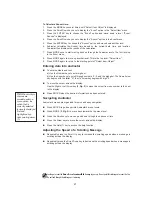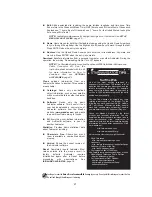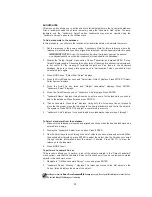
27
쩦
Edit: Edits a selected site, including: the name, latitude, longitude, and time zone. Time
Zone refers to the Greenwich Mean Time (GMT) time zone shift. Users West of Greenwich,
England use “-” hours, East of Greenwich use “+” hours. For the United States, look up the
time zone shift in Table 1.
NOTE: Audiostar compensates for daylight savings time, if selected. See
SETUP
MENU: DAYLIGHT SAVING
, page 25.
쩦
Name: Users may enter both their first and last names using the Up and Down Arrow keys
to cycle through the alphabet. Use the Right and Left Arrow keys to move through the text.
Press ENTER when the entry is complete.
쩦
Address: Use the Up and Down Arrow keys to enter your street address, city, state, and
zip code. Press ENTER when the entry is complete.
Download transfers information from a personal computer or another Audiostar. During the
operation, the warning “Downloading Do Not Turn Off” appears.
NOTE: The Download function requires the optional #505 Astrofinder Software and
Cable Connector Kit.
See the
instruction sheet included with the kit
for more information on how to
download.
Also see
OPTIONAL
ACCESSORIES,
page 32.
Clone
uploads information from one
Audiostar handbox to another. Three options
are available:
쩦
Catalogs: Sends only user-defined
object information, such as new satellite
orbits or comet data to another Audiostar
handbox.
쩦
Software:
Sends only the basic
Audiostar software. This is useful if one
user has downloaded a new version of
Audiostar software from the Meade
website (www.meade.com) and wants
to pass this software along to friends.
쩦
All: Everything, user-defined information
and Audiostar software, is sent to
another Audiostar.
Statistics: Provides basic statistical data
about Audiostar, including:
쩦
Characters Free: Shows how much
room is available in user-defined object
memory.
쩦
Version: Shows the current version of
the Audiostar software.
Reset: Completely resets Audiostar. Most
values entered into the menus revert to
factory defaults.
Audiostar requires
initialization again after a Reset before
proceeding with observations.
See
INITIALIZING AUDIOSTAR
, page 16.
Looking at or near the
Sun
will cause
irreversible
damage to your eye. Do not point this telescope at or near the Sun.
Do not look through the telescope as it is moving.
Surf the Web
One of the most exciting resources for
astronomy is the Internet. The Internet is full of
websites with new images, discoveries, and the
latest astronomical information. For example,
when comet Hale-Bopp made its approach to
our Sun in 1998, astronomers around the world
posted new photos daily.
You can find websites for virtually any topic
relating to astronomy on the Internet. Try the
following key word searches: NASA, Hubble,
HST, astronomy, Messier, satellite, nebula,
black hole, variable stars, extrasolar, Chandra,
gamma burster, comets, Astronomy Day, etc.
Check out Meade’s website for the latest
product and technical information. You can
download the latest software revisions, links to
other astronomical sites, coordinates of
celestial objects, and the latest satellite tracking
information for the Audiostar handbox. You’ll find
our websites at:
http://www.meade.com/
http://www.meade4M.org/
Here are some other sites you might find useful:
•
Sky & Telescope:
http://www.skyandtelescope.com/
•
Astronomy:
http://www.astronomy.com/asy/default.aspx
• Astronomy Picture of the Day:
http://apod.nasa.gov/apod/
• Photographic Atlas of the Moon:
http://www.lpi.usra.edu/resources/lunar_orbiter/
• Hubble Space Telescope Public Pictures
http://hubblesite.org/gallery/
• For the astronomer from Québec:
http://quebec.to/astronomie
http://www2.globetrotter.net/faaq/
astroccd/index.htm
Summary of Contents for starnavigator ng series
Page 8: ...This page folds out...




































